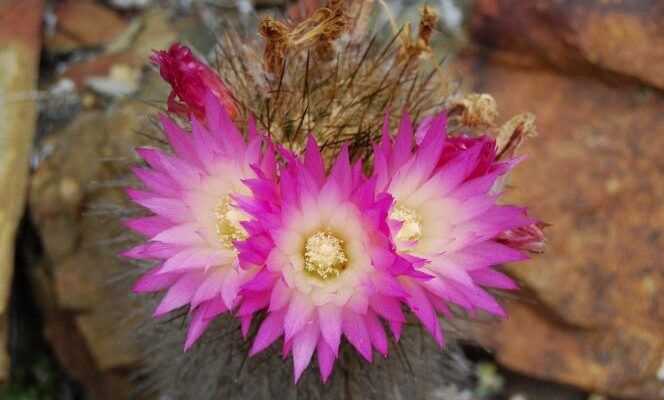VS‘was in February 2020. After receiving a “tip”, the Italian riflemen raided the home of a certain Andrea Piombetti, a well-known cactus collector and seller in Senigallia, a town on the Adriatic coast. It was the start of Operation Atacama – named after the Chilean desert – aimed at dismantling international trafficking in … cacti, writes the New York Times. In November 2020, a similar operation targeted a another cactus trafficker, located a little further north, in Rimini.
In a makeshift greenhouse at Mr. Piombetti’s, the Italian gendarmes discovered about a thousand Copiapoa and Eriosyce, cacti originating in Chile, whose trade is prohibited, under the terms of the Convention on International Trade in Species of Fauna and endangered wild flora (Convention on International Trade of Endangered Species or CITES), also known as the Washington Convention.
It was not the first time that Mr. Piombetti has had a problem with the riflemen. In 2013, during a raid, they seized a shipment of six hundred Chilean cacti from his home. But the case had not had any legal follow-up, due to delays in the procedure and the limitation period.
Cacti more threatened than mammals and birds
In recent years, the cactus has replaced the ficus: the Guardian in 2017 and the New Yorker two years later describe the craze for the one who has become the quintessential “millennial” houseplant. But some wealthy amateurs are not satisfied with the species sold in garden centers or from specialists with a storefront.
On some cliffs in Mexico, Peru or Texas
Indeed, it is with cacti like climates of the Burgundy vineyards : many species are very localized. They are only found, for example, on some steep limestone cliffs in Mexico, on a single sandy patch of less than a square kilometer on the coast of Peru, or deep in Texas.
In fact, cacti are even more threatened than mammals and birds and are on the Red List of the International Union for the Conservation of Nature (IUCN). “At present, 31% of cactus species are threatened with extinction », Wrote IUCN in 2015. “The destruction of its habitat, the horticultural industry and illegal trade in general are identified as responsible for the decline of the taxon “, notes for his part the WWF.
Little-known global traffic
Rare species are difficult if not impossible to buy legally. This is the reason why international trafficking has developed, which has nothing to envy to the smuggling of tiger bones, ivory, pangolin scales and rhino horn. But this illegal trade is largely ignored, due to the “Plant blindness”, the cognitive bias which tends to ignore plant species.
However, the customs or nature protection services regularly announce catches which only give an imprecise idea of this smuggling. Thus, in September 2016, French customs announced that they had intercepted 369 cacti belonging to eleven different species of very rare and protected cacti, the value of which was estimated at nearly 80,000 euros.
In 2019, a German tourist couple were arrested at the Denver airport
On the border between Mexico and the United States, the various American federal agencies fight against human and drug trafficking. But not only. In June 2019, a German tourist couple was arrested at Denver airport, accused of trying to bring home endangered cactus seeds. In February 2021, New Zealand authorities announced the conviction of a woman accused of smuggling endangered succulents and cacti between New Zealand and China.
In Arizona, the Saguaros, majestic tree cacti, which are the attraction of the national park of the same name, are also the target of traffickers, recalls the magazine Geo. For this cactus, the value is mostly determined by the size (about $ 200 per thirty centimeters): “But, as soon as the cactus has multiple arms and takes on its popular candelabra shape, the price soars. It then fluctuates between 5,000 and 10,000 dollars, to the point that some owners include it in their home insurance. “
Yet once they slip through the cracks, they are easily found in luxury plant stores in Japan, on eBay, Instagram, Etsy or Facebook, notes the New York Times.
Return the cacti to Chile
Operation Atacama made it possible to retrace part of the route of Mr. Piombetti’s cacti. According to investigators, he visited Chile seven times, the last time in December 2019, where he collected cacti near the Pan de Azúcar National Park.
Authorities say February 2020 catch is valued at nearly $ 1.2 million
Then he sent plants to Greece and Romania, where the customs services are less careful, or to Japan. According to the authorities, the February 2020 catch is valued at nearly $ 1.2 million on the black market (more than 980,000 euros).
Generally, confiscated cacti are destroyed by the Italian authorities, except when it comes to rare species, continues the New York Times. After the raid of the Carabinieri, the cacti were stored in the botany department of the University of Milan. But because of their specific needs, keeping them in Italy was like letting them die.
At the end of 2020, the Milan Botanical Garden, IUCN and a plant lover from Baltimore (Maryland) paid the necessary costs for the return trip of the cacti to Chile. At the end of April, 844 cacti had returned to their native land, a hundred had died and 84 remained in Milan for study.
